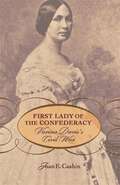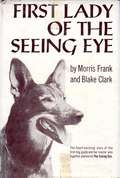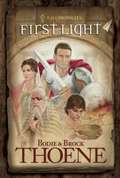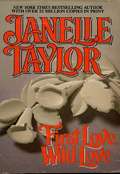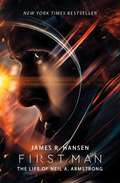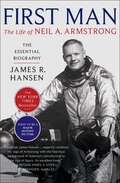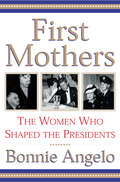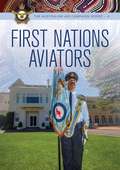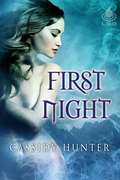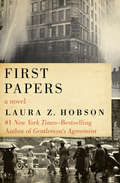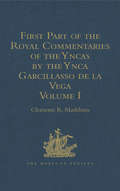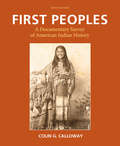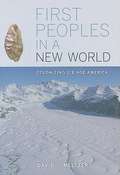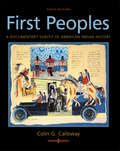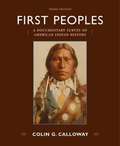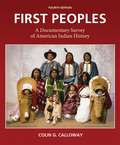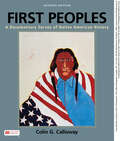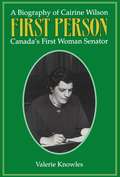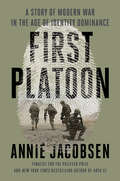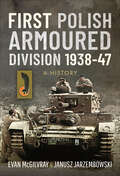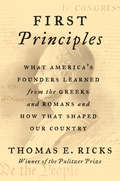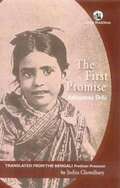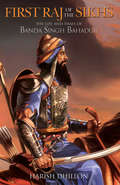- Table View
- List View
First Lady of the Confederacy: Varina Davis’s Civil War
by Joan E. CashinWhen Jefferson Davis became president of the Confederacy, his wife, Varina Howell Davis, reluctantly became the First Lady. For this highly intelligent, acutely observant woman, loyalty did not come easily: she spent long years struggling to reconcile her societal duties to her personal beliefs. Raised in Mississippi but educated in Philadelphia, and a long-time resident of Washington, D.C., Mrs. Davis never felt at ease in Richmond. During the war she nursed Union prisoners and secretly corresponded with friends in the North. Though she publicly supported the South, her term as First Lady was plagued by rumors of her disaffection. After the war, Varina Davis endured financial woes and the loss of several children, but following her husband's death in 1889, she moved to New York and began a career in journalism. Here she advocated reconciliation between the North and South and became friends with Julia Grant, the widow of Ulysses S. Grant. She shocked many by declaring in a newspaper that it was God's will that the North won the war. A century after Varina Davis's death in 1906, Joan E. Cashin has written a masterly work, the first definitive biography of this truly modern, but deeply conflicted, woman. Pro-slavery but also pro-Union, Varina Davis was inhibited by her role as Confederate First Lady and unable to reveal her true convictions. In this pathbreaking book, Cashin offers a splendid portrait of a fascinating woman who struggled with the constraints of her time and place.
First Lady of the Seeing Eye
by Morris Frank Blake ClarkThis story written by Morris Frank tells of how he trained in Switzerland with Buddy, the first Seeing Eye dog in America. Also tells of the very early history of The Seeing Eye in Morristown N.J. "Here are adventures that encompass thirty years and countless of miles: the fight to have dog guides admitted to restaurants and hotels, trains and planes; lectures and demonstrations all over the country; meetings with millionaires and Presidents--and with mountaineers and truckdrivers; and the humor and pathos of day-to-day events. The story begins on page 11. Un-numbered pages of photos, described and with captions, are between pages 64 and 65.
First Lady: The Life of Lucy Webb Hayes
by Emily GeerLucy Webb Hayes, married to Rutherford B. Hayes, served as First Lady of the United States from 1877-81. This was an important transitional era in nineteenth-century American history, when the country was still recovering from the Civil War, and a new modern economic and social world was being born. Lucy was the first presidential wife to hold a college degree, and in this way was a role model for the "new woman." Still, as a married woman, she was expected to serve as White House hostess, manage her household, supervise family life, and be a loving and supportive wife. Lucy fulfilled all these roles admirably, with propriety and Christian morality, and was much praised in Washington DC and across the nation for her grace and charm. Where she may have failed the "new woman" was in supporting her husband's view of women's suffrage, which he thought entailed the exercise of political duties that were inconsistent with the demands of maternity. Lucy and her husband famously held a temperance policy for entertaining at the White House, which was a political as much as a moral decision. Historians have often falsely blamed Lucy for this stance, dubbing her "Lemonade Lucy." This comprehensive biography uncovers the truth about the intelligent, warm-hearted woman, adored and respected by her family, who was the ideal nineteenth-century political wife.
First Light (The A.D. Chronicles, Book #1)
by Bodie Thoene Brock ThoeneSpiritual and political darkness shroud the world's holiest and most turbulent city. Ruled by Rome and manipulated by religious rulers with only selfish interests in mind, the people of Jerusalem wonder if their Deliverer will ever come. Susanna and Manaen desperately search for hope and meaning - in a world where their love is forbidden. Others pray and wait for light, the True Light of Messiah, to dawn. Peniel the beggar, Marcus the Roman Centurion, Zadok the Chief Shepherd of Israel, and his three adopted orphan boys - all long for a vision of hope. Now a healer named Yeshua walks the streets of Jerusalem. Is he the true Messiah? Or only another imposter, like so many before him?
First Love Wild Love
by Janelle TaylorReared in the civilized society of far-off England, Calinda Braxton was unschooled in the ways of passion until she arrived in the exotic wilds of the untamed western frontier and a rugged, gunsliging stranger stole into her hotel room--and her bed! Roused from slumber by his breathless kisses, the beguiling innocent surrendered to her bold seducer's virile charms. . .never dreaming that he was a Texas ranger on a dangerous secret mission. . .or that his searing caress would awaken her heart to the soul-stealing ecstasy of a magnificent, once-in-a-lifetime love!
First Man: The Life of Neil A. Armstrong
by James R. HansenSoon to be a major motion picture, this is the first—and only—definitive authorized account of Neil Armstrong, the man whose “one small step” changed history.When Apollo 11 touched down on the Moon’s surface in 1969, the first man on the Moon became a legend. In First Man, author James R. Hansen explores the life of Neil Armstrong. Based on over fifty hours of interviews with the intensely private Armstrong, who also gave Hansen exclusive access to private documents and family sources, this “magnificent panorama of the second half of the American twentieth century” (Publishers Weekly, starred review) is an unparalleled biography of an American icon. In this “compelling and nuanced portrait” (Chicago Tribune) filled with revelations, Hansen vividly recreates Armstrong’s career in flying, from his seventy-eight combat missions as a naval aviator flying over North Korea to his formative trans-atmospheric flights in the rocket-powered X-15 to his piloting Gemini VIII to the first-ever docking in space. For a pilot who cared more about flying to the Moon than he did about walking on it, Hansen asserts, Armstrong’s storied vocation exacted a dear personal toll, paid in kind by his wife and children. For the near-fifty years since the Moon landing, rumors have swirled around Armstrong concerning his dreams of space travel, his religious beliefs, and his private life. A penetrating exploration of American hero worship, Hansen addresses the complex legacy of the First Man, as an astronaut and as an individual. “First Man burrows deep into Armstrong’s past and present…What emerges is an earnest and brave man” (Houston Chronicle) who will forever be known as history’s most famous space traveler.
First Man: The Life of Neil A. Armstrong
by James R. HansenMarking the forty-fifth anniversary of Apollo 11's moon landing, First Man by James Hansen offers the only authorized glimpse into the life of America's most famous astronaut, Neil Armstrong--the man whose "one small step" changed history."The Eagle has landed." When Apollo 11 touched down on the moon's surface in 1969, the first man on the moon became a legend. In First Man, Hansen explores the life of Neil Armstrong. Based on over fifty hours of interviews with the intensely private Armstrong, who also gave Hansen exclusive access to private documents and family sources, this "magnificent panorama of the second half of the American twentieth century" (Publishers Weekly, starred review) is an unparalleled biography of an American icon. Upon his return to earth, Armstrong was honored and celebrated for his monumental achievement. He was also--as James R. Hansen reveals in this fascinating and important biography--misunderstood. Armstrong's accomplishments as engineer, test pilot, and astronaut have long been a matter of record, but Hansen's unprecedented access to private documents and unpublished sources and his interviews with more than 125 subjects (including more than fifty hours with Armstrong himself) yield this first in-depth analysis of an elusive American celebrity still renowned the world over. In a riveting narrative filled with revelations, Hansen vividly recreates Armstrong's career in flying, from his seventy-eight combat missions as a naval aviator flying over North Korea to his formative transatmospheric flights in the rocket-powered X-15 to his piloting Gemini VIII to the first-ever docking in space. These milestones made it seem, as Armstrong's mother Viola memorably put it, "as if from the very moment he was born--farther back still--that our son was somehow destined for the Apollo 11 mission." For a pilot who cared more about flying to the Moon than he did about walking on it, Hansen asserts, Armstrong's storied vocation exacted a dear personal toll, paid in kind by his wife and children. For the forty-five years since the Moon landing, rumors have swirled around Armstrong concerning his dreams of space travel, his religious beliefs, and his private life. In a penetrating exploration of American hero worship, Hansen addresses the complex legacy of the First Man, as an astronaut and as an individual. In First Man, the personal, technological, epic, and iconic blend to form the portrait of a great but reluctant hero who will forever be known as history's most famous space traveler.
First Mothers: The Women Who Shaped the Presidents
by Bonnie AngeloIn this highly acclaimed book, Bonnie Angelo celebrates a group of remarkable women who played a pivotal role in developing the characters of the modern American presidents — their mothers. Angelo, a veteran reporter and writer for TIME magazine, explores the lives, thoughts and feelings of these women who so influenced the twentieth century’s most powerful leaders. From the aristocratic and formidable Sara Delano Roosevelt to diehard Democrat Martha Truman, from stoic Hannah Milhous Nixon to the hard-living Virginia Clinton Kelly, First Mothers is an in-depth look at the special mother-son relationship that has nurtured America’s presidents and helped them to achieve great things. A veteran correspondent at TIME magazine and the first woman to head a TIME foreign bureau, Bonnie Angelo has reported on the White House and presidential families throughout eight administrations. As a Washington correspondent and bureau chief in London and New York, she has covered newsmakers and major events in all fifty states and around the world. “A fascinating book, gracefully written ... gives the reader fresh insights into how the characters and values of our recent presidents were shaped.” — Washington Post Book World
First Nations Aviators
by RAAF History and Heritage BranchThe inaugural Royal Australian Air Force Oral Histories series publication, First Nations Aviators, will introduce you to a number of First Nations People who have proudly served the Air Force, in various capacities, from the Second World War through to today. Albeit brief, their stories are particularly inspirational considering the discrimination that occurred on enlistment, and their treatment after separating from the Armed Services, at that time. Their stories should help to reveal and acknowledge those First Nations People for the heroes that they are and the recognition that their families are due. First Nations Aviators provides the perfect backdrop to introduce this series as we start with &‘First Nations People&’, the very people who have already been protecting Australia and its interests for more than sixty thousand years!
First Night
by Cassidy HunterOne clan whose men can't impregnate their women. One clan that does their duty. One woman who wants a baby more than anything. One man who gives her the chance. A terrible curse, jealousy, revenge, and attempted murder. Join Lake in a race against time to save the woman he loves and his unborn child.Mila lives with her shadow and her people in a cursed clan. The Myaian men cannot get their women pregnant, and in order for their people to survive, sympathetic outsider clans determined to do their duty donate their men to the Myaian women, but only one man every two years.When Mila is chosen, she is ecstatic. She wants a baby more than she's ever wanted anything--at least until she meets the huge Ednian, Lake.In spite of a rocky start, the two can't deny the bonds that begin to form between them, both physically and emotionally.Then Mila's shadow nearly kills her. Lake, determined to get her and his future child away from danger, takes her damaged and unconscious to his people.Mila isn't about to let him rule her life. When he refuses to allow her to return to her village to see to her people, she sneaks away and runs straight into the arms of a nightmare.Now her only hope of surviving is the man she left. Will he reach her in time to save not only her, but the child she carries?Content Notes: M/F, Explicit Sexual Content, Graphic Language, Voyeurism, Exhibitionism, Anal Play, Non Sexual Violence
First Papers
by Laura Z. HobsonTwo Russian socialists emigrate to the United States and begin the long process of becoming American in this novel by a #1 New York Times–bestselling author. Stefan and Alexandra Ivarin emigrated to America at the end of the nineteenth century. Russian Jewish socialists, the Ivarins are now established in a Long Island home designed, somewhat haphazardly, by Stefan. Despite their attempts at assimilation, the Ivarins find themselves still struggling to find a balance between their Russian roots and their American lives, between their past and their future—and those of their children. Based in part on Laura Z. Hobson&’s own childhood, First Papers is a tender portrait of the tension involved in embracing a foreign culture full of opportunity while longing for a lost homeland, and &“a warm-hearted novel&” by the author of Gentleman&’s Agreement (The Sunday Herald Tribune).
First Part of the Royal Commentaries of the Yncas by the Ynca Garcillasso de la Vega: Volume I (Containing Books I, II, III, and IV)
by Clements R. MarkhamTranslated and Edited, with Notes and an Introduction, From the 1609 Lisbon edition. Continued in First Series 45. This is a new print-on-demand hardback edition of the volume first published in 1869.
First Peoples
by Colin G. CallowayFirst Peoples was Bedford/St. Martin's first "docutext" - a textbook that features groups of primary source documents at the end of each chapter, essentially providing a reader in addition to the narrative textbook. Expertly authored by Colin G. Calloway, First Peoples has been praised for its inclusion of Native American sources and Calloway's concerted effort to weave Native perspectives throughout the narrative. First Peoples' distinctive approach continues to make it the bestselling and most highly acclaimed text for the American Indian history survey. Bedford Digital Collections for Native American History To give you more options for sources, we are offering five projects from the Bedford Digital Collections, bundled free with the purchase of a new text. This online repository of discovery-oriented projects offers both fresh and canonical sources ready to assign. Each curated project poses a historical question and guides students step by step through analysis of primary sources. Featuring: Pontiac's War, 1763-1765 Eric Hinderaker, University of Utah Building a Creek Nation: Reading the Letters of Alexander McGillivray Kathleen DuVal, University of North Carolina at Chapel Hill Debating Federal Indian Removal Policy in the 1830s John P. Bowes, Eastern Kentucky University Sand Creek: Battle or Massacre? Elliott West, University of Arkansas Fayetteville The Laguna Pueblo Baseball Game Controversy of the 1920s Flannery Burke, St. Louis University
First Peoples in a New World: Colonizing Ice Age America
by David J. MeltzerMore than 12,000 years ago, in one of the greatest triumphs of prehistory, humans colonized North America, a continent that was then truly a new world. Just when and how they did so has been one of the most perplexing and controversial questions in archaeology. This dazzling, cutting-edge synthesis, written for a wide audience by an archaeologist who has long been at the center of these debates, tells the scientific story of the first Americans: where they came from, when they arrived, and how they met the challenges of moving across the vast, unknown landscapes of Ice Age North America. David J. Meltzer pulls together the latest ideas from archaeology, geology, linguistics, skeletal biology, genetics, and other fields to trace the breakthroughs that have revolutionized our understanding in recent years. Among many other topics, he explores disputes over the hemisphere's oldest and most controversial sites and considers how the first Americans coped with changing global climates. He also confronts some radical claims: that the Americas were colonized from Ice Age Europe or that a crashing comet obliterated the Pleistocene megafauna and nearly wiped out people as well. Full of entertaining descriptions of on-site encounters, personalities, and controversies, this is a compelling behind-the-scenes account of how science is illuminating our past.
First Peoples: A Documentary Survey Of American Indian History
by Colin G. CallowayFirst Peoples: A Documentary Survey Of American Indian History
First Peoples: A Documentary Survey of American Indian History
by Colin G. CallowayA survey of the Native tribes in America from before colonization to present times.
First Peoples: A Documentary Survey of American Indian History
by Colin G. Calloway"First Peoples" distinctive approach to American Indian history has earned praise and admiration from its users. Created to fill the significant need for a survey text that acknowledges the diversity of Native peoples, respected scholar Colin G. Calloway provides a solid course foundation that still allows instructors to emphasize selected topics of interest to them and their students. The signature format of "First Peoples" strikes the ideal balance between primary and secondary source material, combining narrative, written documents, and visual documents in each chapter.
First Peoples: A Documentary Survey of American Indian History
by Colin G. CallowayFirst Peoples' distinctive approach continues to make it the bestselling and most highly acclaimed text for the American Indian history survey. Respected scholar Colin G. Calloway provides a solid foundation grounded in timely scholarship and a narrative that brings a largely untold history to students. The signature "docutext" format of First Peoples strikes the ideal balance, combining in every chapter a compelling narrative and rich written and visual documents from Native and non-Native voices alike. An expansion by two full chapters presents a more diverse and nuanced picture of the history of Native peoples in America.
First Peoples: A Documentary Survey of Native American History
by Colin G. CallowayCalloway, First Peoples is the best-selling and most respected Native American history textbook. The text features a rich collection of primary source documents along with an easy-to-read narrative and plentiful assessments and tools in Achieve to support learning.
First Person: A Biography of Cairine Wilson Canada's First Woman Senator
by Valerie KnowlesCairine Wilson, Canada’s first female senator, was one of nine children raised in an atmosphere of rugged Scots liberalism and strict presbyterianism by affluent Montreal parents in the late nineteenth century. She displayed an interest in politics early in life and through her father’s position in the Senate, was befriended by many notable politicians of the period, including Sir Wilfrid Laurier, an experience that left a permanent mark on her. Her appointment to the Senate in 1930 was a historic and controversial event, and launched a political career rife with passion, commitment, and reform. Wilson, whose work on behalf of refugees and the world’s needy was legendary, served in the Senate through some of the stormiest years in Canadian government history. First Person is an engaging account of a colourful and powerful politician; a fighter whose efforts were recognized by the highest officials in the land, and whose sculpted image adorns the foyer of the Canadian Senate.
First Platoon: A Story of Modern War in the Age of Identity Dominance
by Annie JacobsenAn urgent investigation into warfare, good, and evil in the age of biometrics, the technology that would allow the government to identify anyone, anywhere, at any time This is a story that starts off close and goes very big. The initial part of the story might sound familiar at first: It is about a platoon of mostly nineteen-year-old boys sent to Afghanistan, and an experience that ends abruptly in catastrophe. Their part of the story folds into the next: inexorably linked to those soldiers and never comprehensively reported before is the U.S. Department of Defense&’s quest to build the world&’s most powerful biometrics database, with the power to identify, monitor, catalogue, and police people all over the world. First Platoon is an American saga that illuminates a transformation of society made possible by this new technology. Part war story, part legal drama, it is about identity in the age of identification. About humanity—physical bravery, trauma, PTSD, a yearning to do right and good—in the age of biometrics, which reduce people to iris scans, fingerprint scans, voice patterning, detection by odor, gait, and more. And about the power of point-of-view in a burgeoning surveillance state. Based on hundreds of formerly classified documents, FOIA requests, and exclusive interviews, First Platoon is an investigative exposé by a master chronicler of government secrets. First Platoon reveals a post–9/11 Pentagon whose identification machines have grown more capable than the humans who must make sense of them. A Pentagon so powerful it can cover up its own internal mistakes in pursuit of endless wars. And a people at its mercy, in its last moments before a fundamental change so complete it might be impossible to take back.
First Polish Armoured Division 1938–47: A History
by Evan McGilvray Janusz JarzembowskiThe First Polish armored Division was formed in Scotland in February 1942 from Polish exiles who had escaped first Poland and then France. Its commander, Stanislaw Maczek, and many of its men had previously served in Polish 10th Motorized Cavalry Brigade (10 BKS), which had taken part in the Polish invasion of Czechoslovakia in 1938 and given a good account of itself in the defense of Poland against German and Soviet invasion of 1939. Under Maczek’s leadership the division was trained and equipped along British lines in preparation for the invasion of France. Attached to 1st Canadian Army, the division was sent to Normandy in late July 1944. It suffered heavily during Operation Totalize but went on to play a crucial role in preventing an orderly German withdrawal from the Falaise Pocket by its stand at Hill 262. They then played their part in the advance across Western Europe and into Germany. This detailed history, supported by dozens of archive photos, concludes by looking at the often-poor treatment of Maczek and his men after the war.
First Principles: What America's Founders Learned from the Greeks and Romans and How That Shaped Our Country
by Thomas E. RicksThe Pulitzer Prize-winning journalist and #1 New York Times bestselling author offers a revelatory new book about the founding fathers, examining their educations and, in particular, their devotion to the ancient Greek and Roman classics—and how that influence would shape their ideals and the new American nation. <p><p> On the morning after the 2016 presidential election, Thomas Ricks awoke with a few questions on his mind: What kind of nation did we now have? Is it what was designed or intended by the nation’s founders? Trying to get as close to the source as he could, Ricks decided to go back and read the philosophy and literature that shaped the founders’ thinking, and the letters they wrote to each other debating these crucial works—among them the Iliad, Plutarch’s Lives, and the works of Xenophon, Epicurus, Aristotle, Cato, and Cicero. For though much attention has been paid the influence of English political philosophers, like John Locke, closer to their own era, the founders were far more immersed in the literature of the ancient world. <p> The first four American presidents came to their classical knowledge differently. Washington absorbed it mainly from the elite culture of his day; Adams from the laws and rhetoric of Rome; Jefferson immersed himself in classical philosophy, especially Epicureanism; and Madison, both a groundbreaking researcher and a deft politician, spent years studying the ancient world like a political scientist. Each of their experiences, and distinctive learning, played an essential role in the formation of the United States. In examining how and what they studied, looking at them in the unusual light of the classical world, Ricks is able to draw arresting and fresh portraits of men we thought we knew. <p> First Principles follows these four members of the Revolutionary generation from their youths to their adult lives, as they grappled with questions of independence, and forming and keeping a new nation. In doing so, Ricks interprets not only the effect of the ancient world on each man, and how that shaped our constitution and government, but offers startling new insights into these legendary leaders. <p> <b>A New York Times Bestseller</b>
First Promise
by Ashapurna Debi Indira ChowdhuryIn a deceptively easy, conversational style, through episodes that sketch out the rituals, the quarrels and predicaments of women's lives, a compelling story emerges upon the landscapes of rural Bengal and colonial Calcutta.
First Raj of the Sikhs: The Life and Times of Banda Singh Bahadur
by Harish DhillonBanda Singh Bahadur appeared in Sikh history for a relatively short period (1708-1716) but, after the Sikh gurus, influenced it more significantly than any other individual. Banda Singh Bahadur is among the most colourful and fascinating characters in Sikh history. From an ascetic he was transformed into Guru Gobind Singh’s most trusted disciple. So much so that when the seriously injured guru could not lead his Sikh army against the Mughal forces, he appointed Banda Singh Bahadur as his deputy. As proof of this appointment he gave Banda his sword, a mighty bow, arrows from his own quiver, his battle standard and his war drum. Banda rode out from Nanded (where Guru Gobind Singh passed away; now in Maharashtra) at the head of a small band of Sikhs, which, by the time it reached the Punjab, had grown into a formidable army. Over the next few years his exploits against the Mughal rulers, both in pitched battles and in skirmishes, became the stuff of legends. He became the first of many legendary Sikh generals, famous both for their personal heroic courage and their skill in warfare. His many encounters with the Mughal rulers eroded the very foundation of the Mughal empire and ensured its quick demise. As he said when questioned on what he had achieved: ‘I have ensured that never again will the crown sit easily on the Mughal emperor’s head.’ He also prepared the coming generations of Sikhs for future conflicts, which later greatly helped Maharaja Ranjit Singh in creating a Sikh empire. Banda was a true leader who led from the front, not only in the battlefield but also in civil administration. He established a secular government which swept aside 700 years of slavery and the myth of domination by foreign powers, proclaimed freedom of worship, allowed the people to follow professions of their choice and stopped forcible marriages even while recovering abducted women for return to their families. His land revolution abolished zamindari in parts of North India, thereby redistributing land equally amongst the tillers. This book seeks to tell the story of this remarkable and brave man and his equally remarkable ahievements. Perhaps, the finest of Banda Singh Bahadur’s biographies.
